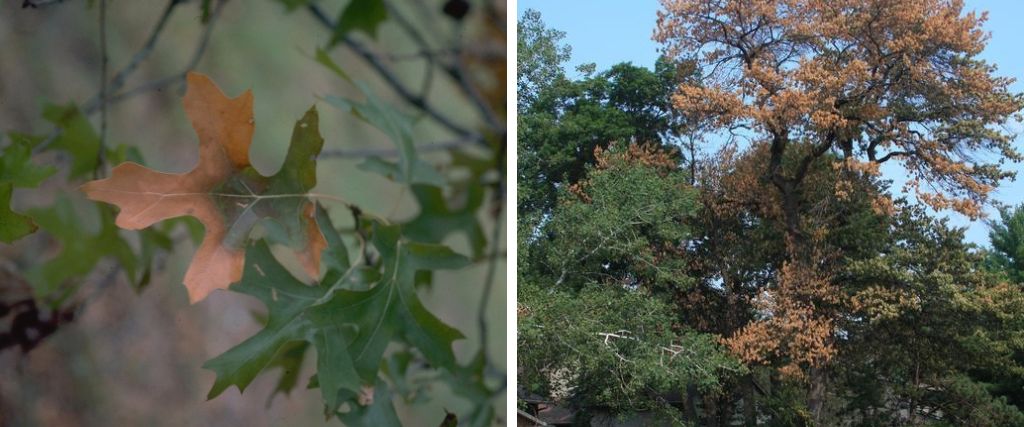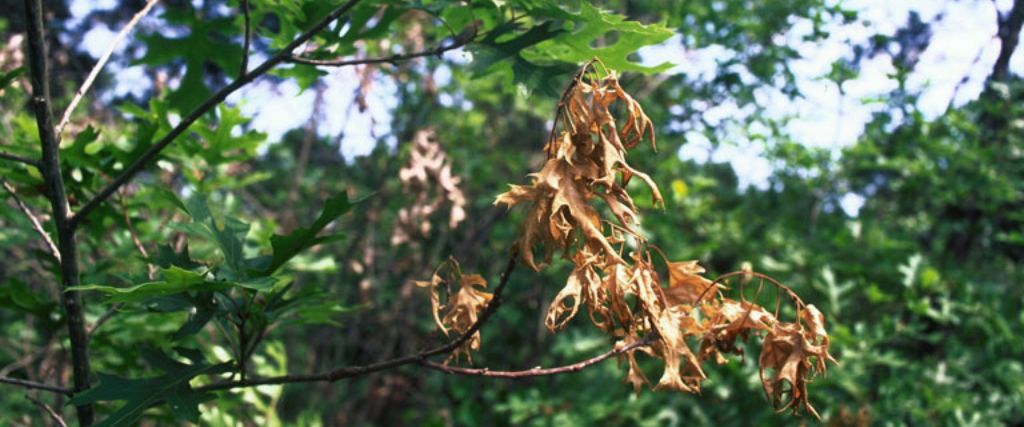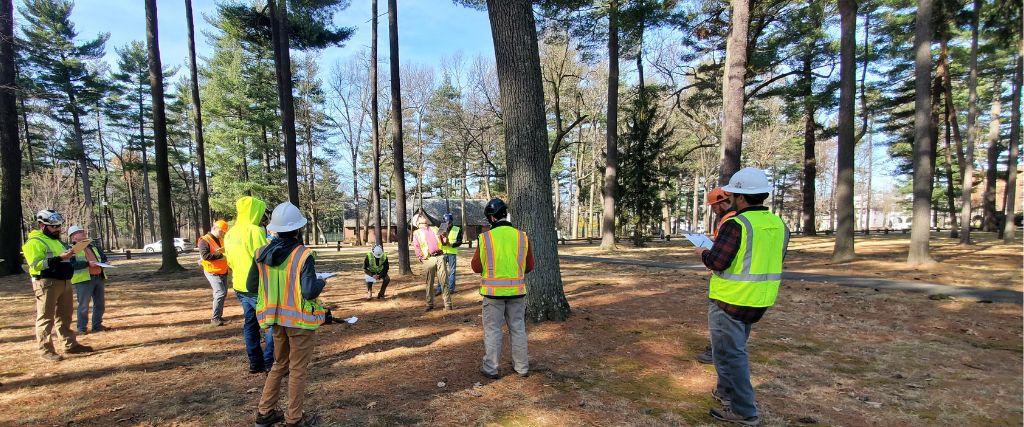Oak wilt is a lethal fungal disease that poses a significant threat to the Garden State’s official state tree, the northern red oak, as well as all oak species found in our state. The disease is fatal and has no cure. Infected trees die quickly, usually within a year (and some as quickly as a few weeks!), and the disease spreads rapidly to nearby healthy trees.
I’ve talked with many homeowners worried about how their oak trees may be affected by this deadly disease. So, to address any questions you may have about oak wilt in northern New Jersey, I’ve put together this guide to help you understand the threat oak wilt poses to your trees and landscape. It covers everything you need to know about the disease, including:
- a description of oak wilt disease
- where cases of oak wilt have been confirmed near us
- how it affects oak trees and why it’s so lethal
- symptoms to look for (including how symptoms differ across oak species)
- what causes the disease
- how oak wilt spreads (and why it spreads so quickly)
- options for dealing with infected trees (unfortunately, options are severely limited)
- what to do if you suspect your tree may be affected by oak wilt
Key Takeaways
- As of spring 2024, there are no confirmed cases of oak wilt in New Jersey, but it is in neighboring states and expected to be found soon in our state.
- Oak wilt rapidly kills trees; by the time you see visible symptoms, it may be too late to save the tree.
- Common symptoms include discolored leaves, branch dieback, and premature leaf drop.
- Treatment options include using preventive fungicides and removing infected trees to control the spread.

Left: A close-up look of oak wilt on leaves by Paul A. Mistretta, USDA Forest Service, Bugwood.org
Right: Large yard tree killed by oak wilt, photo by Steven Katovich, Bugwood.org
What is oak wilt?
Oak wilt is a fungal disease that infects oak trees of the genus Quercus. Arborists first identified the disease in the 1940s in the Mississippi River Valley. It has since spread across the country’s eastern portion, stretching from Texas to the eastern seaboard.
At this time (spring 2024), there are not yet any confirmed cases of oak wilt in New Jersey. However, arborists have diagnosed oak wilt in neighboring states such as New York and Pennsylvania, and most believe it will be a threat to New Jersey in the coming years. The New Jersey Forest Service is working with Rutgers University to test samples and monitor any infections in the area.
Oak wilt quickly infects trees and causes rapid mortality. This means careful vigilance and an inspection from our insect and disease control team can be crucial to keeping your oak trees healthy stopping the spread of this lethal disease.
How does oak wilt affect trees?
When the fungus infects the tree, it clogs up the water transportation system within the tree (the xylem tissue), preventing water from reaching the tree’s canopy and leading to extensive wilting.
Trees infected with oak wilt will quickly become sick and can die within weeks or months of infection. As such, fast action is critical to save infected trees and prevent spreading the fungus to other trees.
Are some trees more prone to oak wilt than others?
Oak wilt is deadly to all oak trees, so you will need to be on the lookout for potential symptoms no matter what kind of oak tree you may have.
However, reports have indicated that red oak trees are more susceptible to the infection than white oak trees. A red oak tree may die within a few weeks of initial infection, while a white oak tree may take over a year to perish from exposure to oak wilt.

Oak Wilt, early symptoms on foliage, photo by Ronald F. Billings, Texas A&M Forest Service, Bugwood.org
What are the symptoms of oak wilt?
Oak wilt acts fast and detecting it is difficult. You will want to seek professional help to diagnose your trees. Going it alone may lead to discovering the disease when it’s already too late to save the tree, while an arborist or Licensed Tree Expert can determine if your tree has oak wilt in time to potentially save the tree or others around it.
Complicating the matter is that symptoms appear differently for red and white oaks and often look like other diseases, such as bacterial leaf scorch or anthracnose. The most effective method for identifying oak wilt is through laboratory testing of actively wilting branch samples to determine if the disease is present before any visible signs confirm the diagnosis.
The key symptoms of oak wilt are:
- Leaf discoloration, starting with yellowing or browning at the edges that progresses inward. Distinct lines will be visible between living and dead tissue.
- Sudden wilting or curling of leaves in spring and summer, progressing from the top of the tree downward.
- Premature and extensive leaf drop, often occurring in mid-summer and typically while there is still some green on them. A carpet of leaves under the tree is a good indicator of oak wilt infection as many infected trees will lose more than half their leaves.
- Dead crowns, with the upper portions of the tree being impacted first as the disease spreads rapidly downward.
- Suckering or sprouting at the base of the tree.
Beyond these common symptoms, different oak types exhibit distinctive signs of oak wilt infection specific to their species.
IMPORTANT: If you notice any signs of oak wilt or similar discoloration of your oak tree leaves, you need to call a NJ Licensed Tree Expert and/or ISA Certified Arborist ASAP. We can determine the issue with your trees and attempt to stop it before it kills your tree and spreads to healthy oak trees nearby.
Symptoms of Oak Wilt Infection in Red Oak Trees
The red oak group in northern New Jersey includes the Northern red oak (Quercus rubra), as well as species like scarlet oak (Quercus coccinea), pin oak (Quercus palustris), and black oak (Quercus velutina).
In red oaks, you may first notice leaf bronzing or burnt-looking leaf tips. The symptoms will begin at the tips of the leaves and move toward the stem and midrib over time. A common sign of oak wilt in red oaks is the leaves looking bronze and water-soaked, even when they shouldn’t.
As the disease progresses, you’ll notice the discoloration begin to spread throughout the tree. Typically, the signs of infection are most apparent at the crown of the tree and are often the first sign of trouble.
Fungal spore mats commonly form under the bark of dead red oaks, attracting beetles that spread the disease to other trees.
The final sign of oak wilt is when discolored and green leaves both begin to quickly fall, signaling the advanced stage of the disease.
Oak Wilt Symptoms in White Oak Trees
White oak species native to northern New Jersey include the Eastern white oak (Quercus alba), swamp white oak (Quercus bicolor), chestnut oak (Quercus montana), and dwarf chinkapin oak (Quercus prinoides).
White oak trees are more resilient to the disease and do not always have the same prolific symptoms as red oaks. You may notice similar leaf discoloration as with red oaks, though symptoms usually first appear in only some branches before spreading to the whole tree. White oaks typically show branch dieback for years before eventually dying of the disease.
Spore mats rarely form under the bark of dead white oaks, but a telltale sign of infection in a white oak is discoloration of the outer sapwood. As oak wilt progresses in white oaks, brown to black discoloration commonly develops in the outer sapwood (it may also occur in red oaks but it much less common). If you cut off an affected branch, you’ll see this streaking as a ring of dark spots inside the wood.
What causes oak wilt?
Oak wilt is caused by a tree’s exposure to the fungus Bretziella fagacearum.
How does oak wilt spread?
Oak wilt spreads through two methods, one above ground and the other below.
Sap-Feeding Beetles Spread Fungal Spores
Beetles that feed on the sap from oak trees may spread the fungal spores that cause oak wilt. Fresh tree wounds, such as from pruning or storm damage, as well as the sweet scent emitted by fungal mats beneath the bark of dead oaks, attract a variety of sap-feeding beetles.
When these beetles fly to nearby trees, they bring the fungal spores with them, easily infecting healthy trees that have open wounds. This is the primary reason why we recommend only pruning oak trees during the dormant season when disease-carrying beetles aren’t active.
Oak Wilt Passes from Tree to Tree Through Root Grafts
The roots of oak trees growing near each other grow together (root grafting); this is especially common in trees growing in sandy soil. An infected tree within 50 feet of another likely has grafted roots, allowing the disease to quickly move from one tree to another as sap flows through the root system.
Are there any effective oak wilt treatments for New Jersey trees?
There are two main treatment options arborists in other states have used to attempt to control the spread of oak wilt: fungicide treatments and tree removal.
Fungicide Application for Early Treatment
You should consider fungicide treatments as a preventive measure rather than a cure for oak wilt. However, there have been reports of fungicide treatment helping save trees in the early stages of the disease. You’ll want to discuss the options with a professional arborist who can give you a plan for how best to deal with potential oak wilt.
Your trees will likely need two treatments for fungicide, and most arborists recommend spacing them out 18 to 24 months from each other. In Texas, where oak wilt is common, many arborists have noticed an increased resistance to the disease when trees have regular fungicide treatments. The risk to your trees is minimized when they receive regular, professional treatment.
Tree Removal for Infected Trees
If a tree is already infected and cannot be saved, we will recommend immediate removal of the tree and testing any nearby oak trees for evidence of infection. Removing the tree and carefully disposing of any diseased material can help stop the spread of oak wilt across your property and the rest of the state.
You will also want to remove the tree stump and all roots, as the roots will still contain fungal spores that can be passed to nearby trees whose roots are grafted to the infected trees.
Will my trees die if I don’t treat an oak wilt infection?
If you don’t treat an infected oak, it will die. Oak wilt is incredibly deadly to all oak trees, especially red oaks. In Texas alone, the disease has killed more than one million trees. Oak wilt poses a danger to your trees as well as entire forests, making proactive treatments and constant vigilance vital for avoiding an epidemic.
Call Aspen Tree Service if You Suspect Oak Wilt
While there are not yet any confirmed signs of oak wilt in northern New Jersey, the disease is pushing east through Pennsylvania and arborists have spotted it in several locations in New York. It’s not a question of if New Jersey’s oak trees will be affected by oak wilt, but when it will arrive in our state. It’s best to educate yourself and prepare for oak wilt’s arrival now, rather than waiting until it’s too late
If you notice any potential signs of oak wilt, call the tree health team at Aspen Tree Service immediately. Our team can submit samples for laboratory testing to confirm if your tree is infected with oak wilt, or if it’s something else, such as bacterial leaf scorch. Based on the results, we’ll recommend the best course of action for helping your trees recover or, if necessary, we’ll quickly and safely remove the infected tree.
Give us a call at 201-317-5488 or request an estimate online to arrange a tree inspection or to learn more about what we can do for you and your trees.






